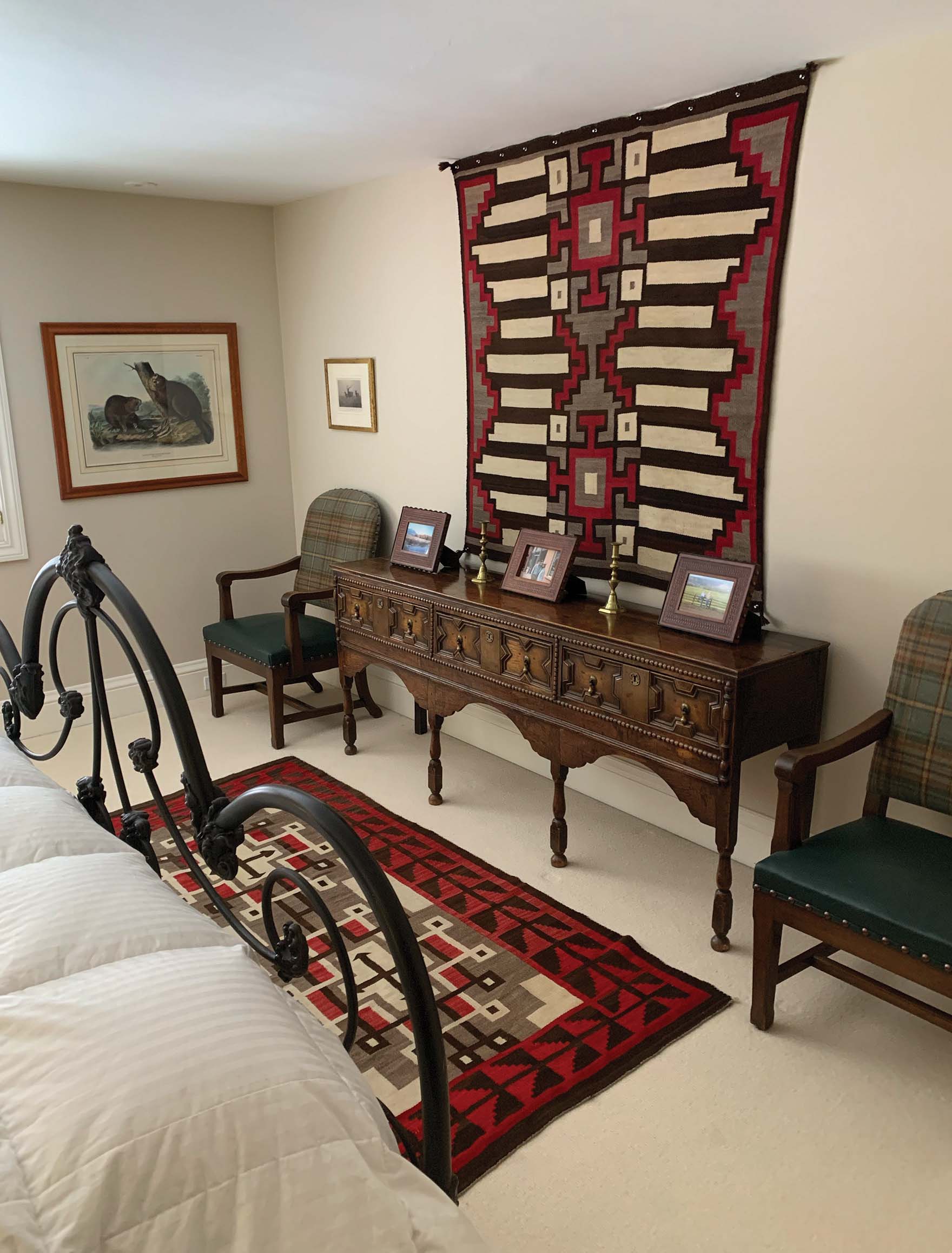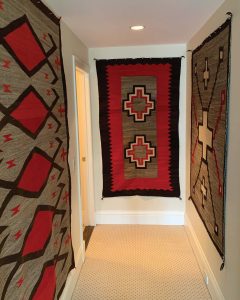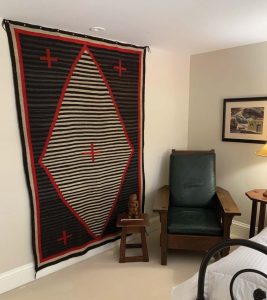
03 Jan COLLECTOR’S NOTEBOOK: PRESERVING WOVEN WORKS
For those who love art and artifacts of the West, handwoven textiles are a fabulous way to infuse Native American history and anthropology into your collection. Textiles created by the Diné, or Navajo, in particular, carry hints of family lineage through symbolism, the wool itself, and the dyes created using local plants. There were distinct periods, too, when wool went from being homespun by the weaver and her family to commercial yarn, which was introduced by traders who’d discovered a thriving market for Native American textiles on the East Coast and encouraged the Diné to use premade yarns, such as Germantown yarn. Soldiers’ blankets were also unraveled and reused, thus introducing another kind of yarn and dyes.

Textile expert Robert Mann recommends using a Velcro hanging system for important woven works, which will not damage the weaving and can accommodate heavier rugs. Photo courtesy of XBX Western
Because these works were created for everyday use, not tribal ceremonies, individual artists or family patterns were not typically documented. However, their purpose as women’s dresses, door covers, or chief’s blankets, for example, make their use a great place to start when learning about weaving. From here, the wise collector, no matter how long you’ve been studying textiles, will want someone with a trained eye to help decipher whether what you’re looking at is authentic and collectible. The price of truly precious works can vary wildly and, to the untrained eye, does not make a lot of sense. For weavings done between 1850 and 1890, for example, the prices can swing in the six-figure range, so finding a trustworthy expert to verify age, quality, dyes, and wool used is invaluable.
If you’ve got textiles and rugs that you suspect are important, you probably have questions about how to display and care for them, especially if they hold some serious value, not only monetarily but historically. Though the most important examples of weaving are in museums or private collections, you still want to handle the ones you own properly. Robert Mann, a textile expert, co-founder of Restoration Yarns, and founder of Robert Mann Rugs, offers some advice on caring for and storing these gorgeous time capsules.
Q: What’s the best way to display textiles that won’t damage them?
Robert Mann: Navajo rugs are occasionally mounted on stretcher frames for a more formal appearance on the wall, and Plexiglass covers can be used but are neither necessary nor a good plan. (They are terribly expensive as well). Velcro is best for hanging woven works and can be affixed to the top and bottom edges for a more ‘formal’ look.
A Velcro hanging system involves having the loop (fuzzy) side of the Velcro machine sewn to a cloth tape, which is then hand-stitched to the back top edge of the textile. Next, a wood strip is prepared by affixing the ‘hook’ side of the Velcro. This wood strip is then attached to the wall with nails or screws. It’s best not to attach Velcro ‘hook’ strips directly to the weaving, as it can damage the fiber. Also, avoid tackless strips, wood clamps, nails, pins, etc. Cloth sleeves with dowels or rods are popular and relatively harmless but do not work as well as Velcro mounts, which can be designed to hold large and heavy textiles safely.
Q: How do you clean weavings? Can you vacuum or put them in a washing machine?
Mann: There are many misconceptions about cleaning Navajo rugs. Navajo rugs often have unstable dyes, and many people have had experiences with home cleaning that have gone badly. Putting a Navajo rug in a washing machine will often destroy it. Consequently, there is a common belief that Navajo rugs cannot be wet cleaned or washed, and that either nothing should be done or that they should be dry cleaned.
In fact, Navajo rugs can be wet cleaned by specialists who are experienced in the process. Art galleries and dealers specializing in Navajo and Southwestern textiles will invariably have a reference for a specialist cleaner. Cleaning is expensive — generally between $6 to $10 per square foot — but the process can be both safe and effective. A skilled cleaner can effectively remove soil, candle wax, animal urine, and other stains.
A serious problem is that people often let their rugs get overly soiled or allow small damages to become unnecessarily large. Aggressive vacuuming and shaking can damage rugs. Restoration is a skilled craft and requires the ability to spin and dye wool yarn to achieve the best results. Home repairs should be limited to simple sewing and patching with fabric. Someone new to Navajo rug collecting can find dealers and galleries specializing in this work by visiting in person or studying websites. There are books, lots of information on the internet, rug auctions, and sale sites that offer information on the topic, too.
Q: When not on display, how should rugs be stored?
Mann: Navajo rugs and Southwestern textiles can be folded — this will not damage them — but the preferred way is to roll them for long-term storage. Wrapping in muslin or sheet fabric is best; plastic bags are less preferred, and cold storage is the safest plan.

Regular maintenance of textiles, such as inspecting them for insects and gently vacuuming them, will ensure that you catch any moth or insect problems before they get out of hand. Photo courtesy of XBX Western
Another area of common misinformation concerns insects. Cedar chests and other herb treatments can help, but they are not a guarantee against moth damage. Freezing kills larvae and live moths but does not destroy moth eggs. Mothballs (naphthalene) can be effective, but they leave a permanent odor in the textile and are to be avoided. Topical sprays can work but are toxic to humans and pets. Regular inspection and vacuuming will generally catch moth issues before they develop. Clean rugs are less prone to moth attack than dirty ones, and cold storage in refrigerators or freezers is a guarantee that moth activity will not be an issue.
Curator and writer Rose Fredrick shares her extensive knowledge about the inner workings of the art market on her blog, The Incurable Optimist, at rosefredrick.com.






No Comments